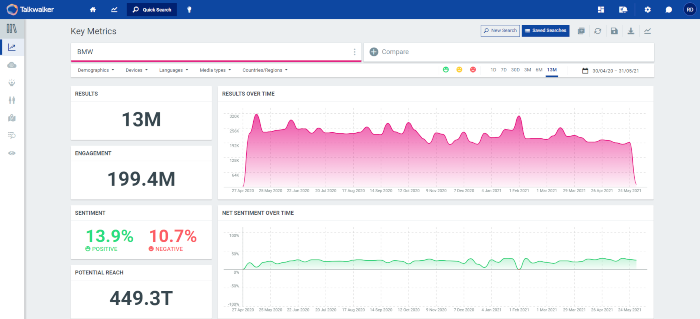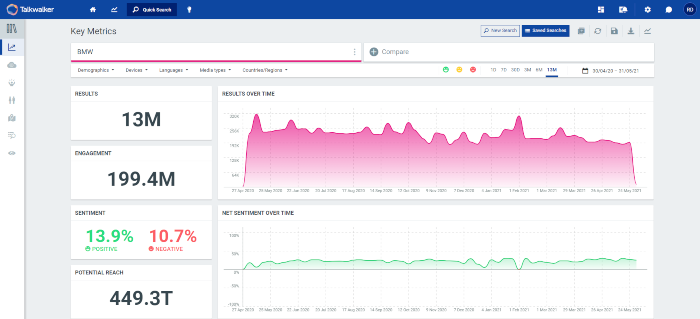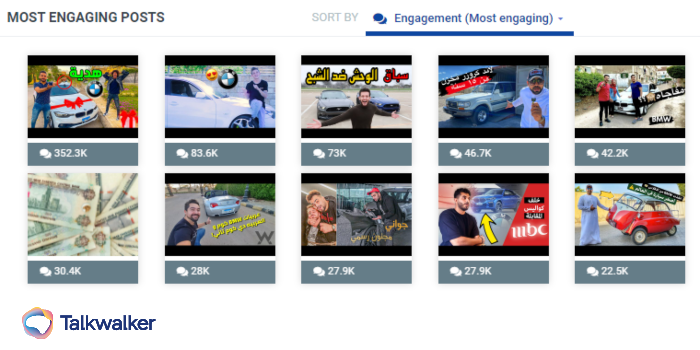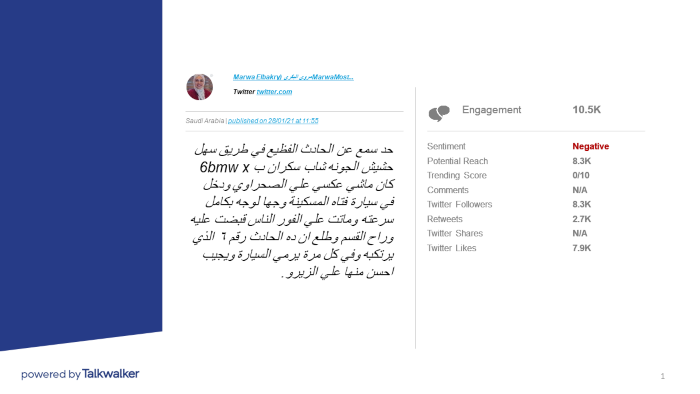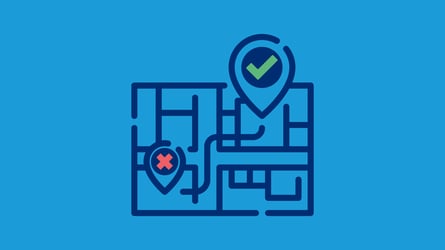Brand experience is the sum of all sensory experiences, emotions, sensations, cognitions, and behavioral responses that result from your branding efforts, whether that’s your logo, website, or your packaging. Having a consistent brand experience solidifies the position that you want to own in the minds of your customer base.
Improve your brand experience strategy today
Brand experience measuring software
Measuring brand experience is difficult, yet a crucial element to the success of your marketing efforts. There are currently several brand experience softwares that provide marketers and brand managers insight into how consumers respond at each touchpoint.
Screenshot of Talkwalker’s Quick Search tool, providing marketers with a holistic overview of how their brand is perceived by a certain demographic over a period of time
Talkwalker has become the brand experience software of choice for over 2000 global brands, aiming to better analyze their customers at every touchpoint. Talkwalker’s powerful platform offers marketers an all-in-one solution to visualize and action data effectively across markets. Talkwalker’s strengths lie in its ability to present seemingly complex conversational data into accessible figures that uncover insights and drive business decisions forward.
On the other hand, there are other solutions like Qualtics’ BrandXM product which has been helping brands like Hugo Boss and Under Armour to transform their brands ‘into an icon’.
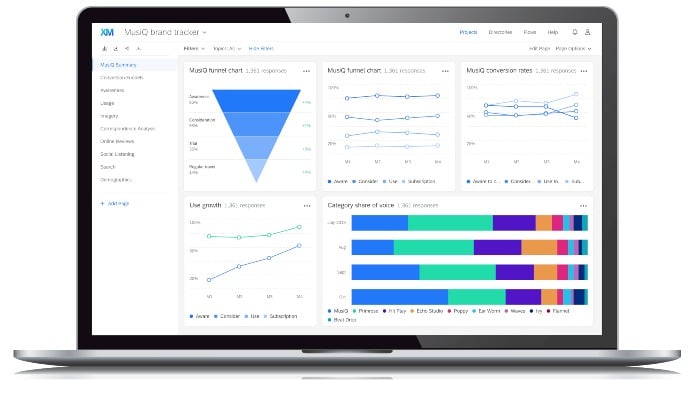
Screenshot of Qualtrics’ BrandXM tool (Source: Qualtrics website)
Also, marketers around the world have been using SAS’s ‘Extended Marketing Impact’ that empowers them to make data-driven decisions around their customer experience.
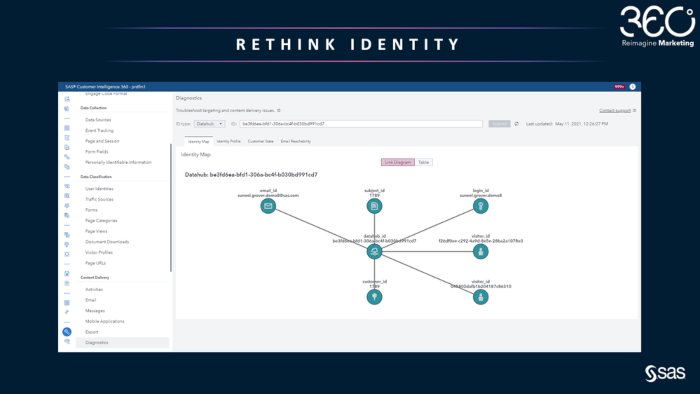
Screenshot of SAS’s tool to better understand customer demographics (Source: SAS Communities Library)
Knowing each brand’s business goals would help tremendously in knowing what to measure and where to look for it. If a brand is focusing on e-commerce, their brand managers would want to know how each customer feels about their interaction with the website (feedback and surveys), whereas if another brand is prioritizing in-store purchasing then they might want to enrich the experience through the smell, lighting, location, and the merchandise positioning.
There is no one-size-fits-all to measuring brand experience, though there are four main dimensions that could guide you to gauge it: sensory relationship, affective reaction, intellectual connection, and behavioral outcome.
Measure your brand experience today
What shapes a brand experience?
An experience with a brand occurs when a potential customer searches for a product or service, buys and receives the item, and finally consumes it. Once that customer experience is fulfilled, consumers form a judgment or an attitude towards the brand they’ve interacted with, which ultimately affects other aspects of their consumer behavior such as return buying or word of mouth.
When consumers are faced with a product or service, they are often presented with its functional attributes and how exactly that product or service solves their problem. However, they also see the brand identity, characterized by its logo, color palette, typefaces, slogans, and much more.
When asked about an interaction with a brand, consumers generally remember those brand identity elements because they subjectively and consciously engage with them, and it is those internal responses that brand managers aspire to learn more about. Why consumers assimilate a brand as being pricey versus cheap, hip versus old-fashioned, or pretentious versus modest.
Don’t confuse your customer experience with brand experience
Not all brand experiences are created equal. Where some are strong and intense, others are easily forgettable. Also, brand experiences differ in valence, where some experiences may either be positive or negative. Lastly, some brand experiences are short-lived and spontaneous, whereas others are more deliberate and intend to last long in people’s minds.
If a brand evokes a positive experience it leads to long-term customer satisfaction and loyalty. For example, imagine walking into a clothing store and one of the employees is frowning at you -- how would that make you feel about the brand? The same analogy could be made if they were extremely friendly and helpful.
Are you optimizing your brand experience?
Measuring brand experience in practice
An easy way to measure your brand experience is by listening to social media channels to fully understand what consumers are talking about when they mention your brand. To go a step further, brand managers could analyze the sentiment surrounding these conversations and monitor trends that are affecting any shifts, whether positive or negative. Sentiment could be affected by numerous elements like the release of a new product, a change in brand image, or even a badly-worded tweet that came from the brand’s Twitter account.
For example, if you are a brand manager for a luxury car manufacturer you would want to look at what type of images are being shared on social media, where your logo is appearing, and how exactly are people engaging with those images.
Sample of the most engaging images that feature the BMW logo in the MENA region during the past 13 months.
It’s crucial to explore the sentiment surrounding these conversations. Looking at the net sentiment surrounding BMW in the MENA region during the past 13 months, I can see that it’s generally all positive with the exception of one negative dip.
Net sentiment surrounding BMW in the MENA region during the past 13 months
As any brand manager must do, I examined the dip for further insights:
The main tweet that drove the overall sentiment around BMW during January towards the negative side.
A Twitter user with the handle @MarwaMostafaEl1 is voicing her frustration towards a drunk driver who had recently caused the death of another driver by recklessly driving his BMW X6 SUV. While this tweet does not directly relate to BMW as a brand, it might result in fostering negative feelings towards the X6.
In any case, choosing the right brand experience software that is capable of delivering real-time insights is a crucial element in your marketing and communications strategy.

